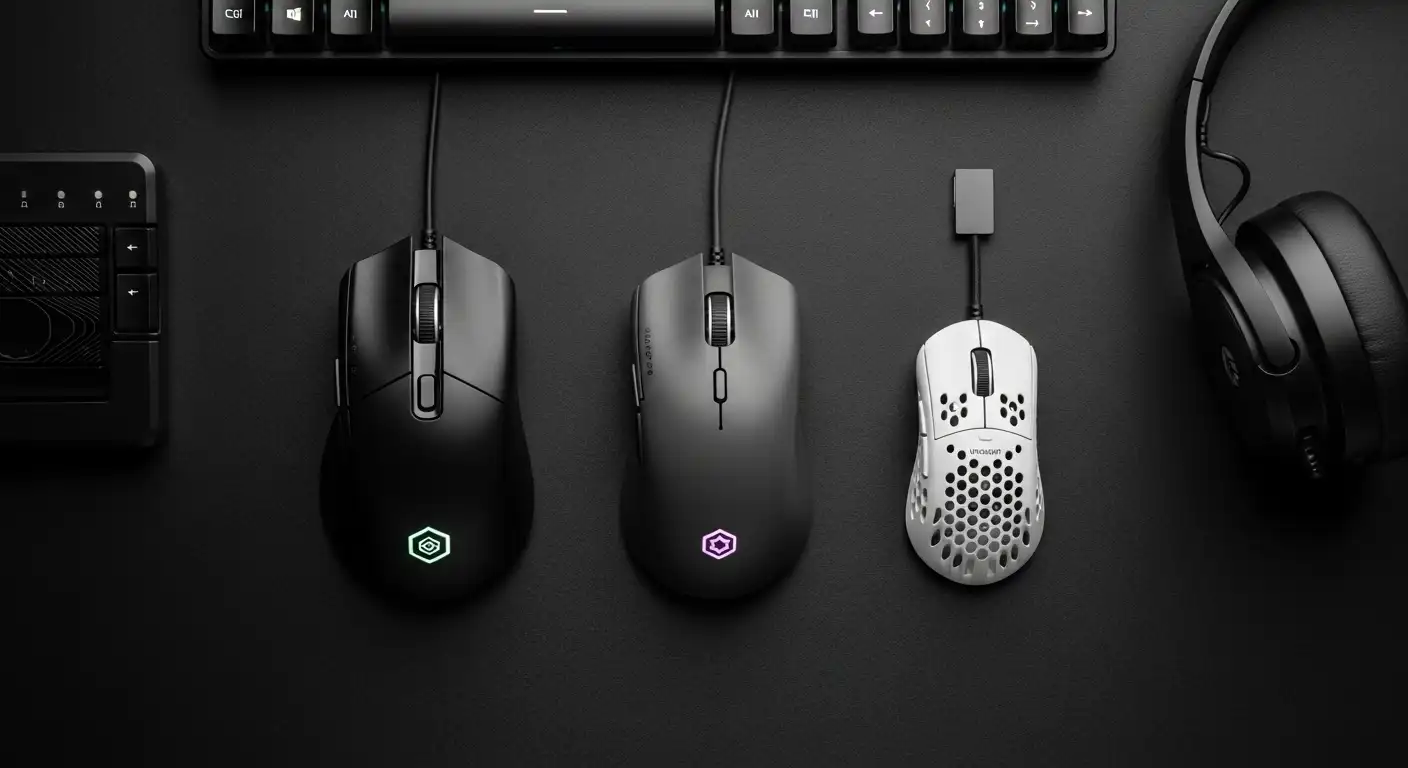In the arsenal of a PC gamer, if the keyboard is your command center for movement and abilities, the mouse is your scalpel. It is the single most important tool for precision. It’s the direct, physical link between your brain’s intent and your in-game aim, the peripheral that dictates whether you land a game-winning headshot or fire into the wall beside your target. A great mouse feels less like a tool you are holding and more like a natural extension of your own hand.
But stepping into the market for a new gaming mouse can feel like walking into a maze blindfolded. You’re immediately bombarded with a dizzying array of technical specifications and arcane terminology. DPI, polling rate, IPS, optical vs. laser, palm vs. claw grip, ergonomic vs. ambidextrous, ultralight vs. heavy—what does it all mean? And more importantly, what actually matters for you?
This guide is your map and your flashlight. For years, I have tested, reviewed, and competed with hundreds of gaming mice, and my mission here is to distill that experience into a clear, comprehensive resource. We will dissect every critical component, from the microscopic technology inside the sensor to the exact curvature of the shell you hold in your hand. By the time you finish this guide, you will not only be able to identify the features of a great gaming mouse, but you will also understand the science and philosophy behind them, empowering you to choose your next mouse with absolute confidence.
The Sensor: The Brains of the Operation
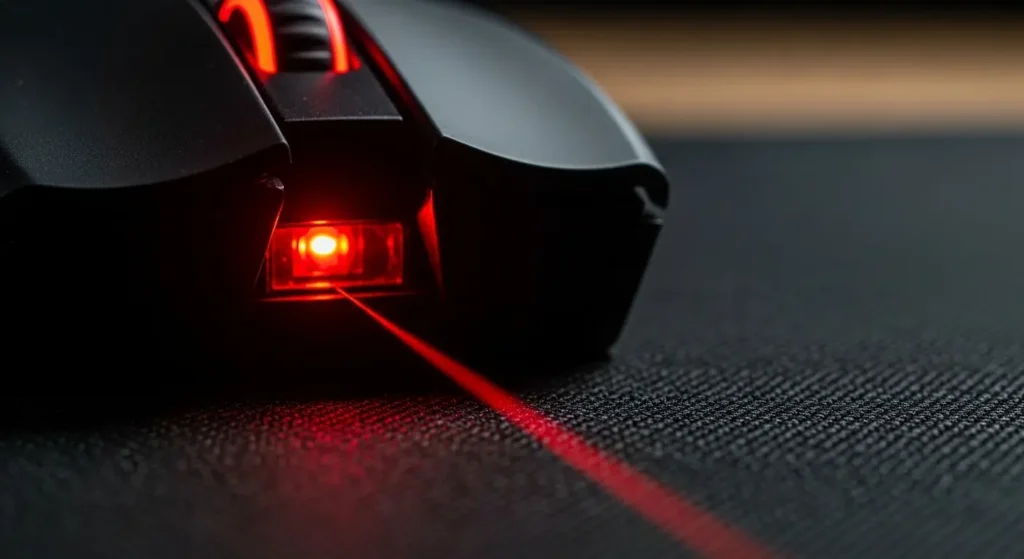
Before we discuss shape, weight, or style, we must start with the heart of the machine: the sensor. This tiny component, nestled in the belly of the mouse, is a sophisticated camera that captures thousands of images of the surface beneath it every second. It’s the brain of the operation, responsible for translating the physical movement of your hand into flawless, pixel-perfect cursor movement on screen. In the past, sensors were a major point of failure, but modern technology has achieved a level of perfection that is nothing short of incredible. Understanding this technology is the first step to recognizing true quality.
Optical vs. Laser: The Modern Standard is Clear
For years, a heated debate raged in gaming forums: optical or laser? Today, that debate is over, and there is a clear winner for gaming.
- Laser Sensors: These use an infrared laser diode to illuminate the surface. Their main advantage is the ability to track on a huge variety of surfaces, including reflective ones like glass. However, they achieve this by reading the surface in such microscopic detail that they can pick up inconsistencies and “jitter,” sometimes leading to slight, unwanted acceleration or deceleration that interferes with pure muscle memory.
- Optical Sensors: These use an infrared or red LED to light up the surface. The images captured by an optical sensor are less “detailed” than a laser, which is paradoxically their greatest strength. They focus on the larger texture of a mousepad, ignoring microscopic imperfections. This results in a raw, 1:1 translation of your hand movement to the cursor, with no unwanted prediction or acceleration. This is the holy grail for competitive gamers who rely on consistent muscle memory.
The Verdict: For gaming, an optical sensor is the undisputed champion. Virtually every single high-performance gaming mouse on the market today from reputable brands like Logitech, Razer, SteelSeries, ZOWIE, and Finalmouse uses a flawless optical sensor. If you see a mouse advertised as having a “gaming-grade laser sensor,” consider it a red flag for outdated technology.
Key Sensor Metrics: Understanding the Numbers That Matter
Manufacturers love to throw big numbers at you. Understanding what they actually mean allows you to see past the marketing hype and focus on what truly impacts performance.
DPI (Dots Per Inch): Debunking the “More is Better” Myth
DPI is simply a measure of sensitivity. If you set your mouse to 800 DPI, moving it one inch physically will move your cursor 800 pixels on screen. A higher DPI means a “faster” cursor. Marketing departments will boast about sensors with 25,000+ DPI, but this is almost entirely for show.
The crucial truth is this: the vast majority of professional and high-level amateur gamers use a relatively low DPI, typically between 400 and 1600. Why? Because a lower DPI forces you to use larger, more deliberate movements of your arm and wrist, which allows for finer, more controlled micro-adjustments and more consistent muscle memory. A high DPI might feel fast, but it makes aiming incredibly twitchy and inconsistent. A high maximum DPI on a sensor is a good indicator of its technical capability, but you will almost never use it at its maximum setting.
Polling Rate (Hz): The Speed of Communication
Polling rate is how frequently your mouse reports its position to your computer. It’s measured in Hertz (Hz).
- 125Hz = 8ms response time (standard office mouse)
- 500Hz = 2ms response time
- 1000Hz = 1ms response time (The Gold Standard for Gaming)
A 1000Hz polling rate means your mouse is communicating with your PC one thousand times every second. This ensures a near-instantaneous, fluid connection with no perceptible lag. Today, 1000Hz is the standard for any respectable gaming mouse, wired or wireless. Some elite-tier mice now offer “Hyper-Polling” at 4000Hz or even 8000Hz, providing updates every 0.125ms. While the real-world benefit is minuscule for most players, it represents the absolute bleeding edge of responsiveness. For 99.9% of us, 1000Hz is perfect.
IPS and Max Acceleration: The True Test of a Sensor’s Stability
These two specs are far more important than max DPI for judging a sensor’s raw performance. They determine how well the sensor can handle fast, aggressive movements without failing.
- IPS (Inches Per Second): This is the maximum physical speed at which you can move the mouse before the sensor loses the ability to track accurately. A good gaming sensor today will have an IPS of 400 or more, meaning you could swipe it across your desk at over 22 miles per hour and it would still track perfectly. This effectively means you will never be able to move your hand fast enough to make a modern, high-quality sensor fail.
- Max Acceleration: Measured in “Gs” (G-force), this is the sensor’s ability to handle rapid changes in direction—like a violent flick—without “spinning out.” A spin out is when you flick your mouse so hard the sensor gets confused and your cursor either shoots straight up or straight down. Any modern sensor with a rating of 40G or 50G is more than capable of handling the most aggressive flicks imaginable.
Leading Sensor Technologies (The Top-Tier Entities)
While many great sensors exist, a few names stand out as the industry benchmarks for flawless performance. When you see these names, you can be assured of top-tier tracking.
- Logitech HERO (High Efficiency Rated Optical): Famous for its perfect tracking and incredible power efficiency, making it the king of long-lasting wireless gaming mice.
- Razer Focus Pro/Focus+ Optical Sensor: Known for its bleeding-edge raw specifications, often boasting the highest DPI and IPS numbers on the market, paired with intelligent features like Asymmetric Cut-Off.
- SteelSeries TrueMove Air/Pro: A family of sensors co-developed with PixArt (the industry’s leading sensor manufacturer), praised for their raw, unfiltered 1-to-1 tracking performance.
Grip Style & Ergonomics: Finding Your Perfect Handshake
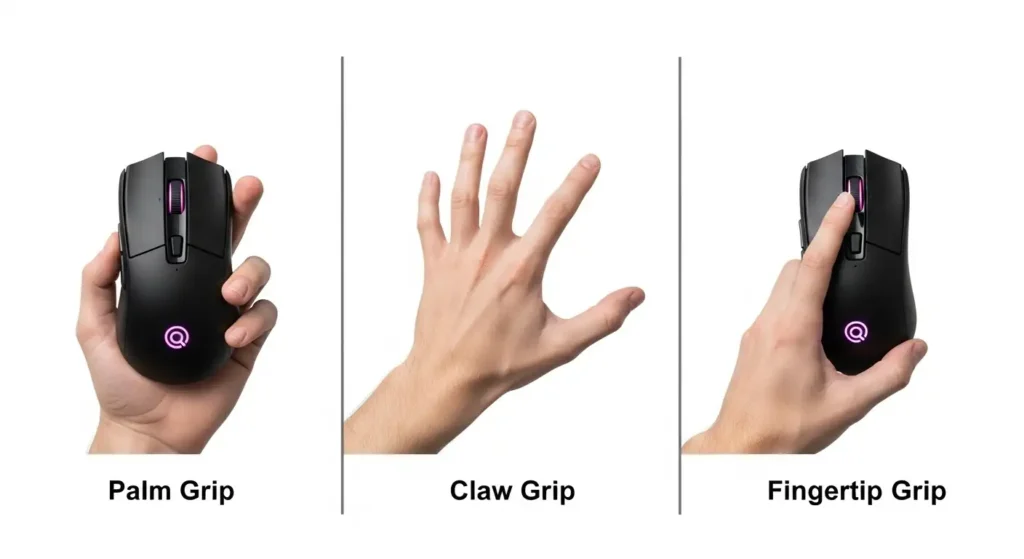
A mouse can have the most advanced sensor in the world, one capable of tracking a single atom on a sub-atomic level, but if holding it is uncomfortable, it’s functionally useless. We must move beyond thinking of ergonomics as just “comfort” and understand it for what it truly is in a competitive context: control. The shape of the mouse dictates how your hand makes contact, which in turn determines which muscle groups—your arm, your wrist, or your fingers you will use to aim. It’s the foundation upon which your muscle memory is built.
Therefore, how you instinctively hold the mouse, your “grip style”, is the single most important factor in determining the right shape and size for you. This is a deeply personal and physical relationship with the hardware; there is no universal “best” grip, only the one that is best for your hand size, your aiming style, and your unique biomechanics. Understanding your own natural grip is not just a preference; it’s the first and most critical step in a process of selection that will unlock your true aiming potential.
The Three Primary Grip Styles: Palm, Claw, and Fingertip
Take a moment to place your hand on your current mouse naturally. How are you holding it? Your grip likely falls into one of these three categories.
Palm Grip: For Stability and Comfort
- How it works: Your entire palm rests on the back of the mouse, and your fingers lie flat or gently curved over the buttons. It’s a relaxed, secure grip with maximum surface contact.
- Best for: Gamers who prioritize comfort and stability, and who tend to aim using their entire arm. The large, stable base makes it excellent for smooth tracking and controlled movements in games like Call of Duty or Battlefield.
- Mouse Shape: This grip is best suited for larger, ergonomic, contoured mice that are designed to fill the hand, such as the classic Razer DeathAdder V3 Pro or the Logitech G703.
Claw Grip: The Versatile Hybrid
- How it works: The back of your palm rests on the very rear of the mouse, but your fingers are arched up in a “claw” shape, with your fingertips pressing down on the buttons.
- Best for: This is a highly versatile hybrid grip. It offers the stability of palm contact with the speed and agility of arched fingers, allowing for very rapid clicking and quick micro-adjustments. It’s extremely popular in tactical shooters like VALORANT and CS:GO.
- Mouse Shape: Claw grippers often prefer medium-sized, ambidextrous mice that allow for vertical finger movement, like the Logitech G Pro X Superlight or the Lamzu Atlantis.
Fingertip Grip: For Maximum Agility
- How it works: This is the most extreme grip. Only your fingertips touch the mouse—your palm makes no contact with the mouse at all. The mouse is controlled entirely by your fingers and wrist.
- Best for: Players who want maximum agility and the ability to make lightning-fast micro-corrections. This grip offers the least stability but the most freedom of movement.
- Mouse Shape: This grip necessitates a very small and, crucially, a very lightweight mouse. The goal is for the mouse to feel like it isn’t even there. Models like the Razer Viper Mini or the G-Wolves Hati S+ are popular choices.
Shape and Size: Ambidextrous vs. Ergonomic
Mouse shapes generally fall into two design philosophies:
- Ergonomic: These mice are specifically contoured to fit a single hand (usually the right hand). They feature curves, thumb rests, and slopes designed to fit the natural resting position of the hand. They are often incredibly comfortable for palm grip and long sessions. The ZOWIE EC series is a benchmark example of ergonomic shape design.
- Ambidextrous: These mice are symmetrical. The left and right sides are mirror images of each other. This “safe” shape makes them suitable for both left- and right-handed users and is highly favored by claw and fingertip grippers for its unbiased form. The Logitech G Pro X Superlight is perhaps the most famous ambidextrous shape on the market.
Weight & Physical Design: The Science of Feel and Glide
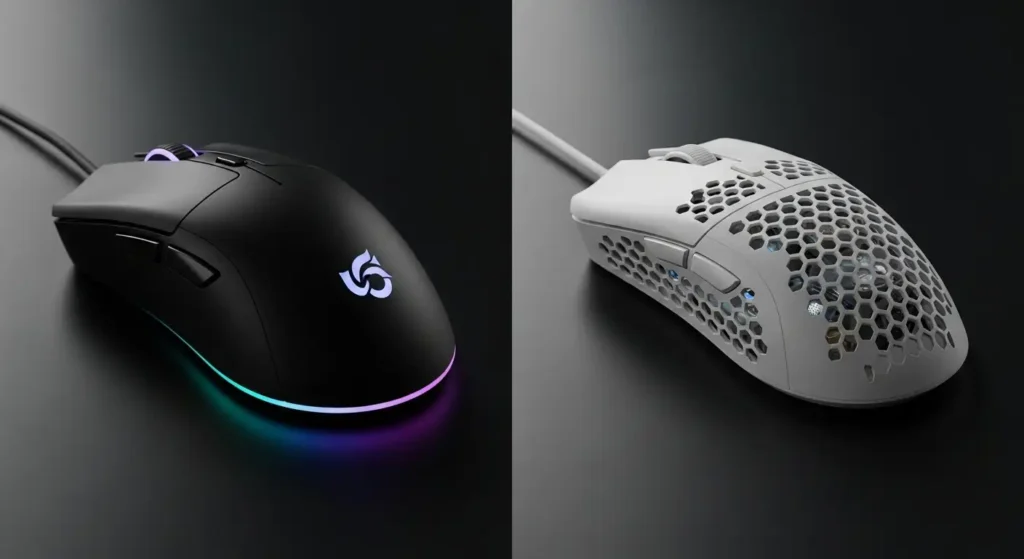
Beyond the sensor’s brain and the shell’s shape, the physical materials and construction of the mouse play a huge role in its overall performance. Think of it like a professional chef’s knife. The blade’s shape is crucial, but the weight, the balance, and the material of the handle are what determine if the tool feels clumsy or like a seamless extension of the hand. This same principle applies directly to a gaming mouse. The surface coating determines your grip and how it handles sweat during intense moments.
The distribution of weight dictates its balance and how it pivots in your hand. These are the elements that create the crucial “first impression” and define the tactile relationship you have with your primary aiming tool.
This tactile experience then translates directly into tangible performance metrics. The construction determines the quality and material of the mouse skates on the bottom, which governs the friction and the smoothness of your glide across the mousepad.
The overall weight is not just a matter of preference; it’s a matter of physics. A lighter mouse has less inertia, meaning it requires less force to start moving and less force to stop, enabling faster flicks and reducing physical fatigue over long gaming sessions. Even the tensioning and housing of the main buttons contribute, defining the crispness of each click and eliminating distracting pre-travel or wobble. These are the engineering details that separate a good mouse from a great one.
The Great Weight Debate: Heavy Control vs. Ultralight Speed
One of the biggest trends in recent years has been the push toward ultralight mice.
- Heavier Mice (80g+): In the past, some mice like the Logitech G502 HERO were popular for their heft and even included optional weights. The philosophy was that a heavier mouse felt more “premium” and provided more stability and deliberate control.
- Ultralight Mice (<70g): The modern school of thought, driven by the esports scene, is that lighter is better. An ultralight mouse (often under 60 grams) is easier to start and stop moving, reducing inertia. This allows for faster flicks, quicker reactions, and significantly less fatigue on your wrist and arm over long gaming sessions. Many modern ultralight mice achieve this low weight through a solid shell design, while others use a perforated or “honeycomb” shell to reduce material.
The Verdict: While some players still prefer a heavier mouse for its feeling of control, the overwhelming competitive trend is toward lightweight designs for their speed and agility.
Mouse Skates/Feet: The Unsung Hero of Smoothness
Often overlooked, the small pads on the bottom of your mouse—the skates or feet—are absolutely critical to its feel. They are the point of contact between your mouse and your mousepad.
- Material: The gold standard material for mouse skates is 100% pure virgin-grade PTFE (Polytetrafluoroethylene), also known by the brand name Teflon. This material provides an incredibly smooth, low-friction glide. Avoid mice that use cheaper, blended materials or standard plastic feet.
- Size and Shape: The size and shape of the skates also matter. Some mice use several small skates, while others use two large ones. Larger skates tend to provide a slightly slower but more stable and controlled glide, while smaller skates can feel faster. Many enthusiasts even replace the stock feet with aftermarket skates from brands like Corepad or Tiger ICE to further tune their glide.
Button Layout and Switch Technology
- Button Count: For most FPS and general-purpose gaming, the standard layout of two main buttons, a scroll wheel, and two side thumb buttons is perfect. For MMO and MOBA games like World of Warcraft or Final Fantasy XIV, you might consider an “MMO mouse” like the Razer Naga or Corsair Scimitar, which feature a side panel with 12 thumb buttons for binding all your abilities.
- Switch Technology: Just like in keyboards, the switches under the main mouse buttons matter.
- Mechanical Switches: The long-time standard, offering a crisp click. Over millions of clicks, however, they can be prone to developing a “double-clicking” issue where a single press registers twice.
- Optical Switches: The new standard. Used by brands like Razer and Roccat, these switches use a beam of light to register a click. Because there are no metal contacts, they are faster, more durable, and physically immune to the double-clicking issues that plague mechanical switches.
Wired vs. Wireless: Has Latency Been Conquered?
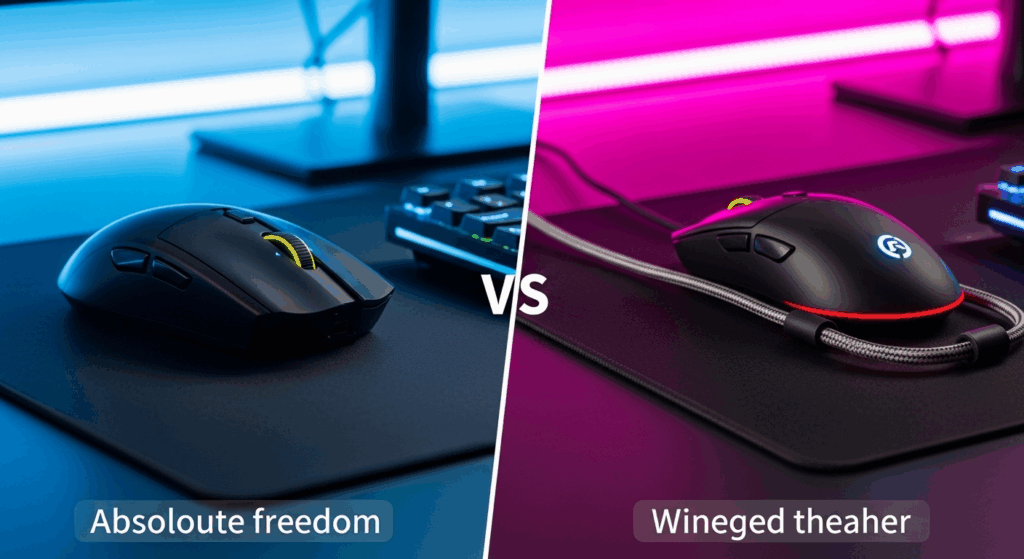
For over a decade, the image of a professional gamer included a taut mouse cable, often suspended by a bungee, as a symbol of their commitment to performance. Competitive players rightly swore by wired mice, fearing the trifecta of wireless woes: input lag, signal interference, and the catastrophic possibility of a dead battery mid-match.
That era of justified skepticism is definitively over. Fueled by massive R&D from leading brands, today’s top-tier wireless technology has not only caught up to its wired counterpart but has, in many ways, created a new gold standard for performance and freedom.
The Modern Reality: 2.4GHz Low-Latency Wireless
The key is to look for mice that use a dedicated, proprietary 2.4GHz low-latency connection via a USB dongle. Technologies like Logitech Lightspeed and Razer HyperSpeed have been engineered to deliver a 1ms/1000Hz polling rate connection that is, for all human-perceptible purposes, just as fast and stable as a wired connection. Pro esports players at the highest levels of competition now use wireless mice daily, which is the ultimate proof that the technology is flawless.
The Trade-offs: Convenience vs. Battery Life
- Wired:
- Pros: Lighter weight (no battery), never needs to be charged, slightly lower cost.
- Cons: The cable can drag on the desk, get caught, and exert a slight force on the mouse, which can interfere with precise movements. (A mouse bungee can help mitigate this).
- Wireless (2.4GHz):
- Pros: Absolute freedom of movement with no cable drag. Creates a much cleaner desk setup.
- Cons: Must be recharged periodically (battery life ranges from 40 to 150+ hours depending on the model and lighting). Slightly heavier than a comparable wired version due to the internal battery. Higher cost.
Putting It All Together: Which Gaming Mouse Is Right for You?

You are now armed with the knowledge to make an informed decision. Let’s synthesize everything into clear recommendations based on playstyle.
- If you are The FPS Sharpshooter: Your priorities are speed, precision, and low weight. You should be looking for an ultralight mouse (<70g) with a flawless optical sensor and a safe ambidextrous or comfortable ergonomic shape that fits your claw or fingertip grip. The standard 2 side buttons are all you need.
- If you are The MMO/MOBA Commander: Your priority is access to abilities. You need an MMO-specific mouse with a 12-button side panel. Weight is less of a concern here; functionality is king. An ergonomic shape is often preferred for comfort during long raids or grinding sessions.
- If you are The Versatile All-Rounder: You play a bit of everything, from RPGs to shooters to strategy games. You need a jack-of-all-trades. Look for a medium-weight mouse (70-90g) with a comfortable, safe shape for your palm or claw grip. A few extra programmable buttons beyond the standard two side buttons can be a welcome bonus.
Ready to Upgrade Your Aim?
Choosing a gaming mouse is a deeply personal journey, but you are no longer navigating it in the dark. You understand the critical role of the optical sensor, the importance of matching shape to grip style, and the real-world trade-offs between wired freedom and wireless convenience. You are ready to find the mouse that doesn’t just feel good, but feels like an extension of your own will.
Now that you know exactly what to look for, the next step is to see how these features manifest in the best products available today. Dive into our detailed, constantly updated guide to the Top 10 Gaming Mice for Accuracy and Speed in 2025 to find the perfect model that fits your hand, your playstyle, and your budget.
